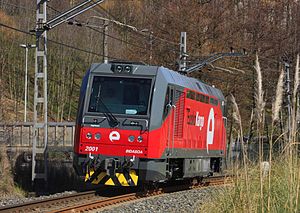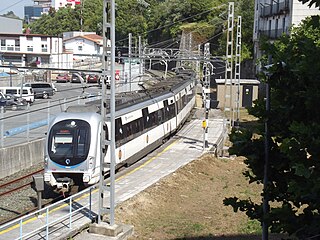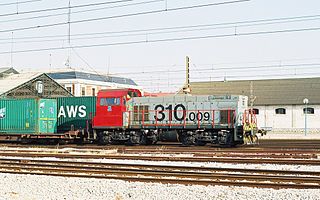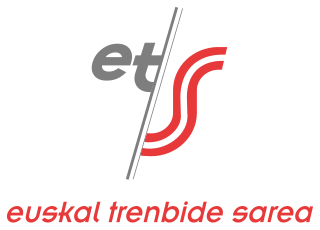| Euskotren TD2000 series | |||||||||||||||||||||||||||||||||||||||||||
|---|---|---|---|---|---|---|---|---|---|---|---|---|---|---|---|---|---|---|---|---|---|---|---|---|---|---|---|---|---|---|---|---|---|---|---|---|---|---|---|---|---|---|---|
 A TD2000 during testing, March 2009 | |||||||||||||||||||||||||||||||||||||||||||
| |||||||||||||||||||||||||||||||||||||||||||
| |||||||||||||||||||||||||||||||||||||||||||
| |||||||||||||||||||||||||||||||||||||||||||
| |||||||||||||||||||||||||||||||||||||||||||
The Euskotren TD2000 series is an electro-diesel locomotive type operated by Euskotren in the Basque Country, Spain.
| Euskotren TD2000 series | |||||||||||||||||||||||||||||||||||||||||||
|---|---|---|---|---|---|---|---|---|---|---|---|---|---|---|---|---|---|---|---|---|---|---|---|---|---|---|---|---|---|---|---|---|---|---|---|---|---|---|---|---|---|---|---|
 A TD2000 during testing, March 2009 | |||||||||||||||||||||||||||||||||||||||||||
| |||||||||||||||||||||||||||||||||||||||||||
| |||||||||||||||||||||||||||||||||||||||||||
| |||||||||||||||||||||||||||||||||||||||||||
| |||||||||||||||||||||||||||||||||||||||||||
The Euskotren TD2000 series is an electro-diesel locomotive type operated by Euskotren in the Basque Country, Spain.
In 2006, Euskotren awarded Ingeteam the construction of 12 diesel-electric locomotives for 37.5 million euros. [1] The first locomotives were delivered in early 2009, [2] and entered service later that year.[ citation needed ] The purchase has been criticized due to the low usage of the locomotives, [3] caused by an overestimation of rail freight demand. [4]
Due to lack of use, one of the locomotives was leased to FGC from 2012 to 2017, where it served as the FGC 255 series. [5] [3] In 2015, three of the locomotives were converted to 1,067 mm (3 ft 6 in) gauge and sold to FE EP, the national railway of Ecuador. [6]
Each unit is named after a river of the Basque Country. [7]

Euskotren Trena, formerly known just as Euskotren is a commuter, inter-city and urban transit train-operating company that operates local and inter-city passenger services in the provinces of Biscay and Gipuzkoa, in the Basque Country, Spain. It is one of the four commercial brands under which Euskotren operates, as a public company managed by the Basque government. The entire 181.1-kilometre (112.5 mi) network uses 1,000 mm narrow gauge rail tracks which have been owned by the Basque Government since their transferral from the Spanish government; the rail tracks and stations were part of the FEVE network until its transferral. Euskotren Trena also operates the Donostia/San Sebastián metro under the brand Metro Donostialdea.

The Bilbao metro is a rapid transit system serving the city of Bilbao and the region of Greater Bilbao. Lines 1 and 2 have a "Y" shape, as they transit both banks of the river Ibaizabal and then combine to form one line that ends in the south of Bilbao. Line 3 has a "V" shape connecting the municipality of Etxebarri with the Bilbao neighbourhood of Matiko; the apex of the "V" is Zazpikaleak/Casco Viejo station, where all three current lines meet. The metro is connected with the Bilbao tram, Bilboko Aldiriak, Euskotren Trena, Feve, Renfe long-distance trains, and Bilbao's bus station. All three lines use metre gauge.

The Renfe Series 333 are high power six-axle diesel-electric locomotives built in the 1970s; at the time of their introduction they were the most powerful non-electric locomotives in Spain.
Euskotren, formally known as Basque Railways, is a public railway company controlled by the Basque Government and officially established in 1982 to operate several 1,000 mm narrow gauge railways inside the autonomous community of the Basque Country, under the terms of the Statute of Autonomy of the Basque Country. Originally operating under the commercial brand ET/FV, it took control of the management and operations of the narrow gauge lines formerly operated by the railway company FEVE. The commercial brand eventually changed to Euskotren, as it remains today. Since 2006, the infrastructure on which the company runs its trains has been owned by Euskal Trenbide Sarea.

Bolueta is a station on lines 1 and 2 of the Bilbao metro. The station is located in the neighborhood of the same name, in the district of Begoña. It opened on 5 July 1997.

Zazpikaleak/Casco Viejo – Zazpikaleak and Casco Viejo – is a railway station in Bilbao, Basque Country, Spain. It is located in the historical neighborhood of Casco Viejo, in the district of Ibaiondo. It links the Bilbao metro rapid transit services with the Euskotren Trena commuter rail network. It is the main railway hub for trips between the metropolitan underground network and the railway services to Eibar, Gernika, Bermeo and San Sebastián as well as the Txorierri valley. The original metro station opened on 11 November 1995, and on 8 April 2017 in its current form.

The Renfe classes 319.2, 319.3 and 319.4 are six axle Co'Co' medium power mainline diesel-electric locomotives manufactured by Macosa using General Motors Electromotive division components under license.

The Renfe Class 310 is a class of 60 four axle Bo'Bo' diesel-electric locomotives for shunting and freight built by Meinfesa with General Motors Electromotive Division components.

The Bilbao tram is a tram system in Bilbao, Basque Country, Spain. Operated by Euskotren under the brand Euskotren Tranbia, it comprises a single 7.8 km (4.8 mi) line, inaugurated on 18 December 2002 and last extended on 25 March 2022.

Euskotren operates frequent commuter rail services in the city of San Sebastián and the surrounding Donostialdea area, in the Basque Country, Spain. The infrastructure is gradually being upgraded to rapid transit standards, in order to create the San Sebastián Metro. The line is commonly known as Topo, due to the large number of tunnels present. As of 2021, the San Sebastián suburban rail services are branded as part of the Euskotren Trena network, with no separate identity.

Line 3 of the Bilbao metro is a rapid transit line in Biscay, Basque Country, Spain. It is 5.9 km (3.7 mi) long and connects Etxebarri and the Uribarri and Otxarkoaga-Txurdinaga districts in Bilbao with the city center.

Kukullaga is the southern terminus of line 3 of the Bilbao metro. The station is also served by Euskotren Trena commuter and regional rail services. The station is located in the neighborhood of Kukullaga, in the municipality of Etxebarri, which is part of the Bilbao metropolitan area. It is one of two metro stations in Etxebarri, the other one being Etxebarri. It opened on 8 April 2017.

The Euskotren 900 series is an electric multiple unit (EMU) train type operated by Euskotren in the Basque Country, Spain.

The Euskotren 950 series is an electric multiple unit (EMU) train type operated by Euskotren in the Basque Country, Spain.

Vencer la ausencia is a Mexican telenovela that aired on Las Estrellas from 18 July 2022 to 4 November 2022. The series is produced by Rosy Ocampo and is the fourth production of the "Vencer" franchise. It stars Ariadne Díaz, Mayrín Villanueva, Alejandra Barros, and María Perroni Garza.

The Euskotren 200 series is an electric multiple unit (EMU) train type operated by Euskotren in the Basque Country, Spain from 1986 to 2018.

Euskal Trenbide Sarea, commonly known by its acronym ETS, is a railway infrastructure manager operating in the Basque Country, Spain. The company was formed in 2004, but the railway infrastructure it operates was transferred from Euskotren in 2006. It is a member of the International Union of Railways.

The ASEA electric locomotive was an electric locomotive type originally operated by Ferrocarriles Vascongados in the Basque Country, Spain. When that company was absorbed by FEVE, it came to be known as the FEVE 4200 series. It was later operated by Euskotren.
Euskotren is a public railway operator in the Basque Country, Spain. Its rolling stock is formed by electrical multiple units used for Euskotren Trena commuter rail services, trams running on the Bilbao and Vitoria-Gasteiz tramway networks, and locomotives for hauling freight trains.
The X'Trapolis Tsíimin K’áak is an electro-diesel multiple unit being built by Alstom. It will be part of the X'Trapolis series of suburban trains. It will be used on the Tren Maya in Mexico, also called Tsíimin K’áak in Mayan. In total, 42 trains will be built, consisting of 4 to 7 cars.